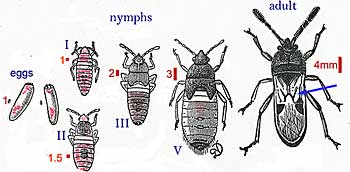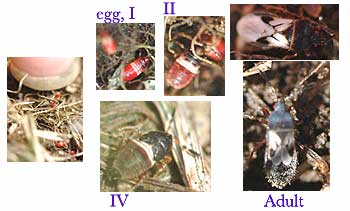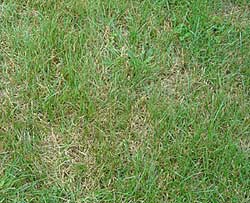VI CONTROL: Overview Acute Cultural Redesign
VII GUIDELINES | VIII PHOTOS | IX REFERENCES
QG CHINCH NOW
| ||||
1. The SpeciesThree species of chinch bug commonly invade turf grass in North America. Only hairy chinch bug (Blissus leucopterus hirtus) occurs in Canada. It is found from Ontario eastward. [C1] The chinch bug is a true bug, meaning it is a member of the order Hemiptera, Bugs are characterized by 'half wings', piercing-sucking mouth parts and a 3 stage life cycle (eggs- nymphs-adults). Most bugs, including chinch, suck plant juices, but some suck blood of other insects. The big eye bug (Geocaris bullatus) is an important predator of chinch bug. 2. Life CycleAdult chinch bugs overwinter in protected places in and around turfgrass. When temperature reaches 7oC in spring, they come out of hibernation and mate. Egg-laying begins about 2 weeks later. Eggs are laid in leaf sheaths and on roots of host grasses. A single female can lay up to 20 eggs per day for 3 weeks or longer. [C1, C2] Time to hatching varies between about one month in early spring, and one week in summer.[C3] In one study, the peak populations of eggs (196 per 0.1 m2 — about 1 x 1 foot or 30 x 30 cm) occurred when white clover was in early bloom; in our regions that is usually in mid-June. [C1] When the eggs hatch, a nymph is released. Nymphs are incompletely formed individuals that start feeding immediately. Nymphs go through a series of five development stages or 'instars' each one larger than the previous one and more similar to the adult. The exoskeleton is shed at the completion of each instar, a process called molting. Successive nymphs are progressively more mobile but do not fly. It takes about 4-6 weeks to reach the adult stage, the shorter periods occurring when temperatures are above average. In our region, adults begin to appear in early to mid-August. [C4] Second-generation nymphs may be produced and do some further damage, but do they do not reach the adult stage. There are two types of adults: short-winged flightless types and long winged types which are capable of flight. The proportions vary between populations. In southern chinch bug, the proportion of long wing forms increases with density of populations, a response which enables them to 'find greener pastures'. [C5] It likely happens in our species also. In late summer and fall, adults seek hibernation sites, including damaged turf with sufficient grass to supply some shelter and food, tall grass, plant debris, under shingles and space around foundations. [C1] 3. Appearance of Chinch BugThe adult chinch bug is only 3-4 mm long. The elongate eggs are less than 1 mm long. They are white at first but become, then turn yellow and finally bright orange just before hatching [C1] The first nymphs are about 1 mm and are bright red, with a white band across their middle. The red changes to orange, orange brown, and black as the nymphs progress through the 5 instars. [C1] Adults are black with shiny white wings. There is a distinctive black spot near the margin of each forewing, and a black line extending diagonally toward the head (see Figure). [C1] Decker remarks: "On casual observation the adults appears to carry a white cross on its back" . [L1] 4. Appearance of Grass Damaged by Chinch BugExpanding patches of yellowing, then dead grass in July and August Olkowski [C12] describes damage by chinch bug as follows: Most damage is caused by nymphs that concentrate in limited areas together with the adults and feed on the same plants until all the available juice has been extracted from the grass. This feeding pattern results in circular patches of damaged grass that turn yellow and then brown as they die. In the yellow stage the grass superficially resembles grass that is drought stressed. As it dies the chinch bugs work outward from the center of infestation, destroying a larger area as they advance.
Affected areas appear initially as scattered patches, with a severe infestation they can coalesce into larger patches. In an Ontario document [L2] first damage is described as "small fist sized sunken areas"; also the dead grass does not pull up easily, which distinguishes it from certain other types of damage. When chinch bugs reach high concentrations, there is a characteristic odor emitted when you walk on the grass. Confirm that the damage is due to chinch bug, not drought or other causes 5. LinksPhotographs on the web illustrating chinch bug
Top of Page I HOME | II BIOLOGY | III MONITORING | IV FACTORS | V PERMITTED MATERIALS VI CONTROL: Overview Acute Cultural Redesign VII GUIDELINES | VIII PHOTOS | IX REFERENCES QG CHINCH NOW Site posted 5 Apr. 2004
This page posted 5 Apr. 2004 Page modified 16 May 2007. |



